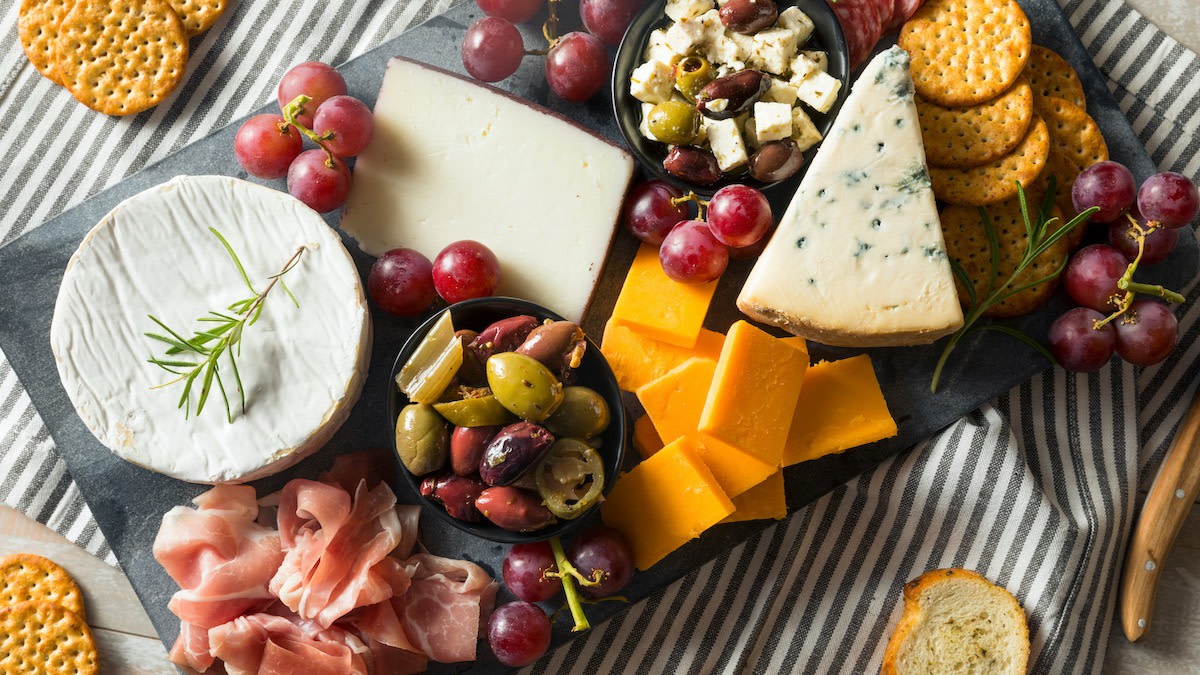How to Cut Cheese for a Charcuterie Board
Written by MasterClass
Last updated: Feb 3, 2022 • 3 min read
Learn how to cut cheese for a charcuterie board, and master the art of arranging a cheese board for your next dinner party. Five types of cheese are ideal for charcuterie boards, and each requires a unique presentation.
Learn From the Best
What Is a Charcuterie Board?
A modern charcuterie board is a platter containing various food items such as wedges of cheese, various meats, pickled vegetables, fresh fruit, and dried fruit. The word “charcuterie” is French, and it largely refers to prepared meat products—particularly pork products. Yet it increasingly has come to involve all types of meat and cheese platters. These items can be displayed on a formal tray, a butcher block, a cutting board, or even a large, shallow bowl.
5 Common Elements of a Charcuterie Board
You can typically find the following items on a charcuterie board.
- 1. Meats: Charcuterie meats tend to be cured or otherwise specially prepared for ease of eating. They include salami, sausage, confit, soppressata, and thin slices of cured hams like Italian prosciutto and speck.
- 2. Cheeses: Charcuterie boards feature both whole blocks of cheese and individual pieces of cheese. Common types of cheese include Parmigiano Reggiano (and other parmesan varieties), gouda, Gruyère, blue cheese, Camembert, Brie, goat cheese, gorgonzola, fresh mozzarella, cheddar cheese, and even cream cheese.
- 3. Pickled vegetables: The most common vegetables found on charcuterie and cheese plates are pickles and olives. Other popular items include sun-dried tomatoes, marinated artichoke hearts, and pickled onions.
- 4. Fruits: Charcuterie boards may include fresh fruit like blueberries, strawberries, raspberries, blackberries, and apple slices. They may also feature dried fruit such as dried apricots, pears, and prunes.
- 5. Accompaniments: Many charcuterie boards supplement their meats and cheeses with crackers, crisps, sliced baguettes, and fresh herbs for garnish and flavor.
How to Cut Cheese for a Charcuterie Board
Different types of cheeses require different cutting techniques.
- 1. Soft cheeses: Soft cheeses like Brie, Camembert, Valençay, and goat cheese logs do best with a traditional cheese knife. Cheese knives have short handles and dull blades, which is all you need for such soft, supple cheeses.
- 2. Semi-soft cheeses: Fontina, Havarti, Limburger, and muenster cheeses are also best paired with a soft cheese knife or a sharper paring knife. You can also slice larger blocks of cheese using a cheese wire.
- 3. Semi-hard cheeses: This category of semi-firm cheeses includes Gruyère, gouda, Manchego, and cheddar. When served at room temperature, they can be cut with a cheese knife, but in many cases, a standard sharp knife, a cheese wire, or a handheld cheese slicer may work better. Rather than let guests cut semi-hard cheeses themselves, some hosts choose to serve pre-cut slices of cheese to spare any headaches.
- 4. Hard cheeses: The hardest of cheeses—parmesan, pecorino, Comté, and heavily aged cheddar cheese—may crumble or flake when you cut them. Sharp knives and small cleavers work best on these cheeses.
- 5. Crumbly cheeses: Some cheeses crumble no matter how you slice them. This is especially true of the ever-popular feta cheese and Roquefort cheese. In these cases, consider pre-crumbling a block of cheese into a bowl and serving it alongside crackers or crisps for easy consumption.
3 Tips for Assembling a Charcuterie Board
Charcuterie boards work brilliantly as both hors d'oeuvres and appetizers. To maximize the enjoyment of your own charcuterie board, follow these three tips.
- 1. Offer a mixture of whole cheeses and pre-cut cheeses. Hard round cheeses like parmesan may fare best when served in a large wedge with the rind still attached. Complement this with thin slices of semi-soft cheese like Havarti and cubes of semi-hard cheese like cheddar or gouda. Softer cheeses like Brie can stay intact; leave the cheese cutting to your guests.
- 2. Make the cheese easy to eat. Cheese looks gorgeous on a charcuterie plate, but it is ultimately there to be eaten. Make the eating process simple for guests by either providing toothpicks to spear cheese cubes or some sort of bread or cracker to place the cheese on.
- 3. Find a way to work in fresh herbs and vegetables. Cheese and meat anchor most charcuterie plates, but the most satisfying ones also feature a few non-animal products. Look for ways to incorporate olives, pickles, and other pickled vegetables for flavor variety. Fresh herbs like rosemary and basil will make your charcuterie plate beautiful, and they will also provide a kick of flavor for guests who choose to eat them with their meat and cheese.
Want to Learn More About Cooking?
Become a better chef with the MasterClass Annual Membership. Gain access to exclusive video lessons taught by the world’s best, including Gordon Ramsay, Gabriela Cámara, Chef Thomas Keller, Dominique Ansel, Yotam Ottolenghi, Alice Waters, and more.
